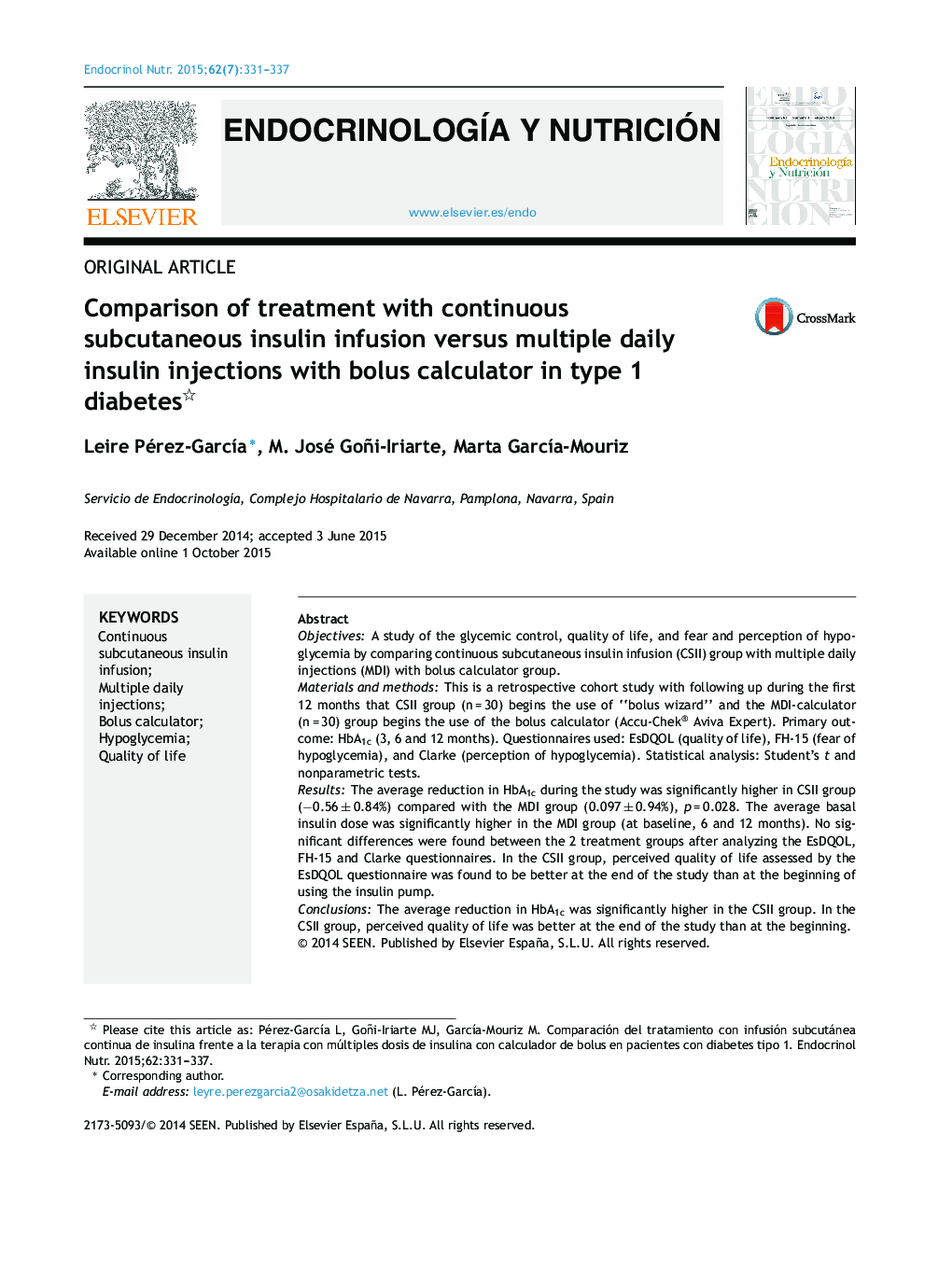| Article ID | Journal | Published Year | Pages | File Type |
|---|---|---|---|---|
| 3266874 | Endocrinología y Nutrición (English Edition) | 2015 | 7 Pages |
ObjectivesA study of the glycemic control, quality of life, and fear and perception of hypoglycemia by comparing continuous subcutaneous insulin infusion (CSII) group with multiple daily injections (MDI) with bolus calculator group.Materials and methodsThis is a retrospective cohort study with following up during the first 12 months that CSII group (n = 30) begins the use of “bolus wizard” and the MDI-calculator (n = 30) group begins the use of the bolus calculator (Accu-Chek® Aviva Expert). Primary outcome: HbA1c (3, 6 and 12 months). Questionnaires used: EsDQOL (quality of life), FH-15 (fear of hypoglycemia), and Clarke (perception of hypoglycemia). Statistical analysis: Student's t and nonparametric tests.ResultsThe average reduction in HbA1c during the study was significantly higher in CSII group (−0.56 ± 0.84%) compared with the MDI group (0.097 ± 0.94%), p = 0.028. The average basal insulin dose was significantly higher in the MDI group (at baseline, 6 and 12 months). No significant differences were found between the 2 treatment groups after analyzing the EsDQOL, FH-15 and Clarke questionnaires. In the CSII group, perceived quality of life assessed by the EsDQOL questionnaire was found to be better at the end of the study than at the beginning of using the insulin pump.ConclusionsThe average reduction in HbA1c was significantly higher in the CSII group. In the CSII group, perceived quality of life was better at the end of the study than at the beginning.
ResumenObjetivosComparar el control glucémico, la calidad de vida, así como el miedo y percepción de las hipoglucemias en el grupo de infusión subcutánea continua de insulina (ISCI) frente a la terapia con múltiples dosis de insulina (MDI) con calculador de bolus.Material y métodosEstudio de cohortes retrospectivo con seguimiento durante los 12 primeros meses desde que el grupo ISCI (n = 30) comienza a utilizar el «bolus ayuda» y el grupo MDI-calculador (n = 30), comienza a utilizar el calculador de bolus (Accu-Chek® Aviva Expert). Variable de desenlace primaria: HbA1c (3, 6 y 12 meses). Cuestionarios empleados: EsDQOL (calidad de vida), FH-15 (miedo a las hipoglucemias), Clarke (percepción de las hipoglucemias). Análisis estadístico: T de Student y pruebas no paramétricas.ResultadosEl descenso medio de HbA1c a lo largo del estudio fue significativamente mayor en el grupo ISCI (−0,56 ± 0,84%) que en el grupo MDI (0,097 ± 0,94%), p = 0,028. La dosis media de insulina basal fue significativamente mayor en el grupo MDI (al inicio, 6 y 12 meses). No se encontraron diferencias significativas entre ambos grupos de tratamiento en los cuestionarios EsDQOL, FH-15 y Clarke. La calidad de vida percibida por los pacientes, valorada mediante el cuestionario EsDQOL, en el grupo ISCI fue significativamente mejor al final del estudio que al inicio de la utilización de la bomba de insulina.ConclusionesEl descenso medio de HbA1c fue significativamente mayor en el grupo ISCI. Se objetivó una mejor calidad de vida en el grupo ISCI al final del estudio que al inicio.
